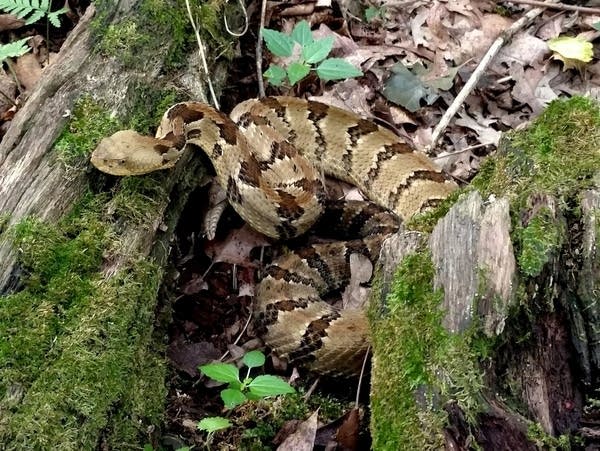Rattlesnake squad comes to the rescue — of the snakes

Go Deeper.
Create an account or log in to save stories.
Like this?
Thanks for liking this story! We have added it to a list of your favorite stories.
When the Winona County Sheriff's Office gets a call from a concerned homeowner about a rattlesnake, dispatchers don’t send out a deputy. Rather, they issue an alert to a group of about 10 volunteers who are trained and certified to handle snakes.
Steve Winter is one of those rattlesnake responders. He's a certified wildlife biologist in Winona, Minn., who knows the first instinct of many people is to kill a rattlesnake. In fact it was long encouraged in Minnesota, where there was a bounty on the timber rattler until 1989.
"I'm aware of how persecuted rattlesnakes are throughout their range in North America," Winter said — which is a big part of the reason why he volunteers for the Minnesota Department of Natural Resources to try to save them.
Unlike many people who fear or even loathe rattlesnakes, Winter admires them.
Turn Up Your Support
MPR News helps you turn down the noise and build shared understanding. Turn up your support for this public resource and keep trusted journalism accessible to all.
“I care about them,” he said. “I don’t want rattlesnakes to be lost to history."
The timber rattlesnake is listed as a threatened species in Minnesota. That means it's illegal to kill one, or even handle it, unless like Winter you have a permit from the DNR.
He signed up about five years ago to respond to calls from people around the Winona area concerned about rattlesnakes. So far this year, he's captured two snakes from near people's homes. He had to crawl under a deck to retrieve one of them.
His tools are large tongs he uses to hold the snake firmly without injuring it, and a snake hook his dad fashioned for him that’s fastened to the end of a golf club handle.
He maneuvers the snakes into a bag the size of a pillowcase, ties it shut, and then relocates them to areas nearby where the DNR has permission from landowners to release them.
In a video he took of a release earlier this month, the snake rattles loudly after it slithers out of the bag, before disappearing into some tall grass.
Winter has never had a rattler strike at him. "The vast majority of the snakes I work with are pretty even-tempered individuals,” he said. “That’s one of the nice things about interacting with the public — they get the opportunity to see that."
So far this summer, the Winona County Sheriff's Office has gotten about 15 snake calls. About half turned out to be rattlers.
That's about the same number as past years, although there was a spike in calls earlier this month when temperatures soared.
That’s to be expected, said Jaime Edwards, manager of the Whitewater Wildlife Management Area, about a half hour outside Winona.
"Normally the snakes are up in the bluffs or in the forest foraging,” she said. “When it gets super hot, particularly on the south and west facing slopes, it's too hot for snakes, and so they'll move down off the bluffs into cooler areas."
But she said the rainy weather has also kept them out of the river bottomlands.
"And so, they're kind of stuck in this middle area, which tends to be where people's homes are," she said.
Edwards is a former nongame wildlife specialist for the Minnesota DNR who helped start the snake responder program.
She said the limited research available suggests that snakes need to be relocated nearby, within a mile of their existing den, or they likely won’t survive.
“We're trying to give them a chance of survival, but also trying to appease the homeowners that have concerns about having them around their property,” Edwards said.

The DNR and local officials will be holding a public meeting 7 p.m. Monday at Holzinger Lodge in Winona for people with questions or concerns about their rattlesnake neighbors.
The fact that rattlesnakes are protected is controversial among some people, Edwards said. They are venomous, after all, so many people wonder why they can't be killed.
The Winona County Sheriff’s Office emphasizes that rattlers see people as predators, not food. Bites are rare, and usually occur when someone tries to handle a snake.
“If you encounter a rattlesnake while you're out and about, the best thing to do is to leave it alone, and it will leave you alone,” the office said in a recent Facebook post.
But most people who have built their homes in snake country realize the rattlers were there first, said Winter.
"They’re accepting of the fact that they live in a rattlesnake neighborhood, and they’re just very happy that there’s a network of volunteers available to come and remove the snakes from their yard," he said.



